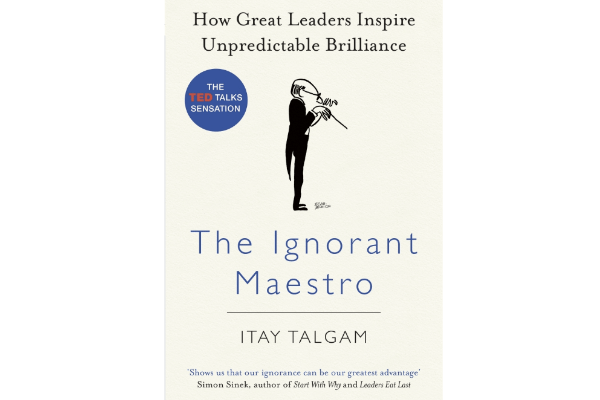
Musical knowledge isn’t required when it comes to understanding lessons of leadership and partnership from great musicians, musical groups, and conductors. Organizations often reflect styles of music, changing and growing over time. Maybe your organization is steady and constant, like a marching band, everyone synchronized with constant forward momentum. Or perhaps it resembles some Dixieland jazz, where there is an overall structure that remains the same but improvisation comes and goes throughout, constantly adding new flavors to the existing framework. But what if that structure gets old and outdated? It’d be time for a change. The point is: there is no one musical style that suits all situations, just as there is no one specific organizational structure or even leadership style that works throughout the lifetime of a single organization – from conception to birth, through growth and beyond.
In his book, The Ignorant Maestro: How Great Leaders Inspire Unpredictable Brilliance, author Itay Talgam takes us through a journey – both of music and of growth. Instead of purporting the best leadership style is x, y, or z, he instead lays out three new themes of leadership, then draws connections between these themes and 6 of the conducting greats throughout history. Below is a brief look into his ideas and new leadership themes, as expressed in the book.
- Ignorance:
Ignorance, you say? That’s the new leadership theme? It sounds like the opposite. But yes, it is in fact a fresh way to view leadership. Just to be clear, there is a difference between stupidity and ignorance. To be consciously ignorant is to embrace not knowing all the answers, or even trying to predict every outcome. Why does this work? It works because it allows room for growth. It allows from for learning from others and for exploring new ideas and challenging situations. When a leader claims to have all the answers, then naturally their followers will look to him/her for any problem. But when a leader shows that not knowing the answer is okay, and s/he pushes the followers to find a solution for themselves, that leader is embracing ignorance as a legitimate leadership tool and validating the learning process itself. This creates a platform for constant and continuous learning and growth. To always be ignorant is to always be aware that there is more to learn. - Gaps:
“Please mind the gap.” Minding the gap is important when exiting the metro, since you don’t want to fall into the unknown abyss that exists in that gap. But in the workplace, minding the gap closes the door to the unknown that lies in that very space. Gaps seem like inherently dangerous areas, but imagine if you stopped to explore the gap. If everyone minded the gap in their work lives, we wouldn’t have rubber, penicillin, or even sticky notes. They weren’t just happy accidents. All of these things were “mistakes” that weren’t just discarded as mistakes, but instead explored as new opportunities. Gaps don’t just occur in the physical manifestations at work, but can show up in human relations as well. You have a new colleague that joins your company. He doesn’t see the value in a process you have at work. Instead of ignoring the gap, or trying to close the gap and explain that “it’s just the way things are done,” maybe you explore the gap and create something new that is a better method for work altogether. Ignoring gaps can create discord. Allowing for, and exploring, gaps aids to harmony and progress in both professional and personal relationships. - Keynote Listening:
Well, you know what keynote speaking is, but I bet you’ve never thought of keynote listening. A keynote speaker comes armed with a joke or two and “material” that needs to be presented, or in other words, information that needs to be downloaded to the audience. A keynote listener is equally focused, but on creating a dialogue instead of transmitting information. Imagine you are a teacher who has to control a large classroom that is rowdy. You tell them to hush, settle down, etc. and nothing words. Why is this? Because your goal is to get them quiet and meet your objectives and they don’t feel heard. Instead of asking them to hush and listen to your oh-so-very-important message, hear them, engage them, and involve them. Maybe you tell them you need their help with a new topic or a trial period for a new idea. Now you aren’t just keynote speaking, but more importantly you are keynote listening. You likely won’t even have to ask them once to listen, because they feel genuinely valued and are now taking part in what you have to say, not just passively listening.
These three themes of leadership show up in each of Talgam’s six case studies, from the general military-like leadership of the great conductor Muti, to the paternalistic control of Toscanini, to the all-encompassing empathetic engagement of the great Leonard Bernstein. But is any one style the “right” style? Is there even a correct way to lead? In short, maybe not. There are moments when you need top down control, and others when you need all team members to feel equally invested and responsible. What we can learn from each of these conductors is one way of going about things, in order to help us expand our own leadership styles. When we try to cut down on our variation, we become narrow and even limited. Expand your view of leadership by taking cues from the greats and finding your own style. No one ever revered an imitator. Grow your authentic self and strive to be flexible and versatile in your own leadership style.
I encourage you to pick up this book today and listen to what the musical world can teach you. Musician or not, Talgam’s messages are extremely relevant and applicable to the corporate world, while also pushing us to step outside of our comfort zones. By taking you into his world, Talgam brings you full circle with tales from his own journeys in the musical and corporate worlds.









